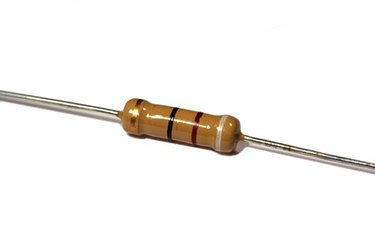
Resistors are used to step down the voltage flowing through a circuit. It is is a fairly simple device. The center of the resistor is made from a material that is only a partial conductor of electricity, like carbon. The general purpose of the resistor is to reduce the voltage of an electric current. When the voltage reaches the part of the resistor that is a poor conductor, the voltage is reduced or stepped down.
Carbon Resistor
Video of the Day
A carbon resistor is the most common type. This is made by wrapping a carbon track around a ceramic core. The carbon track is wound around the ceramic core by a machine or etched into the core with a laser device. Two copper metal leads are then inserted in the ends of the resistor, so the ends of the track are touching the leads. The resistor is then painted to seal the core.
Video of the Day
Metal Film Resistor
A metal film resistor is built in a very similar way. The core of this resistor is crafted from ceramic. This part, as in all resistors, is machine made. In a metal film resistor, the track is made from a metal oxide material. This has semi-conductive properties, similar to carbon. Again, copper leads are inserted into the ends of the resistor using a press machine. These resistors are also painted to finish the product.
Processes
Almost all resistors are manufactured by machine. The ceramic core is molded and pressed by machine. Individual cores are made to fit different sized resistors. The cores are then "wire wound" using another machine that wraps the resistor material around the core. The lead ends, which include both the metal wire and a cap end that is shaped like a bottle cap, are then pressed onto the core. The cores are painted with typical paint or a baked on finish.
Resistance Values
The final step in making a resistor is applying the resistance values to the unit. This is done by painting lines along the painted core of the resistor. Each line has a particular numeric value, which relates to Ohms. For instance black is zero, brown is one, red is two and orange is three. The first two lines are simple numbers, the third is called the multiplier. A resistor with a brown band,red band and orange band therefore would equal 12,000 Ohms. The resistor therefore has a resistance value of 12,000 Ohms.
Accuracy and Tolerance
The next step is to apply the accuracy rating of the resistor. This is the amount of tolerance or accuracy the resistor has. Metal oxide resistors are more accurate than carbon resistors. They have a higher tolerance rating, and therefore are marked with a higher tolerance color. For instance, a gold band has an accuracy of +/- five percent. Silver bands indicate an accuracy of +/- five to ten percent.